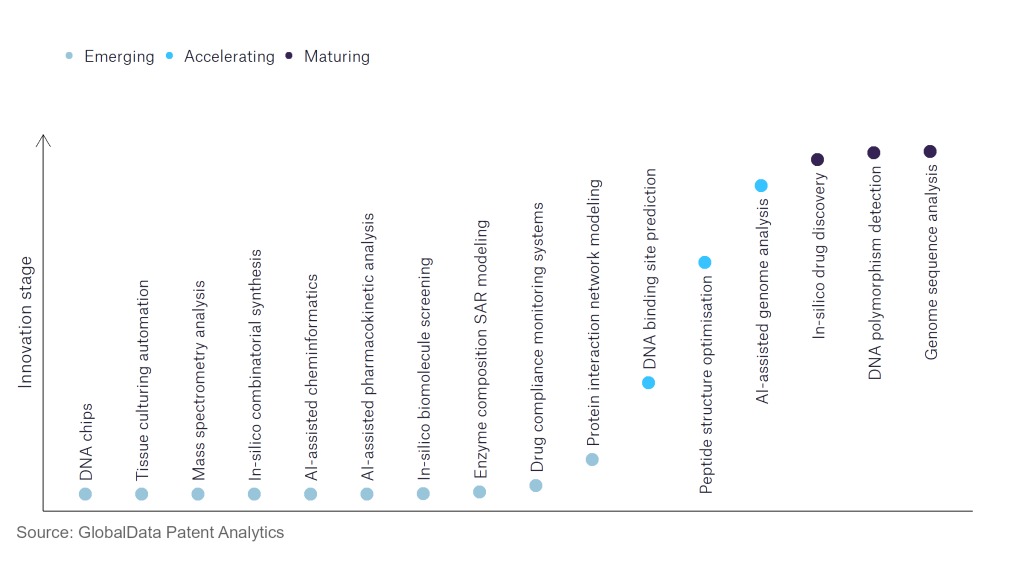The pharmaceutical industry continues to be a hotbed of innovation, with activity driven by the evolution of new treatment paradigms, and the gravity of unmet needs, as well as the growing importance of technologies such as pharmacogenomics, digital therapeutics, and artificial intelligence. In the last three years alone, there have been over 633,000 patents filed and granted in the pharmaceutical industry, according to GlobalData’s report on Artificial Intelligence in Pharmaceuticals: In-silico drug discovery.
However, not all innovations are equal nor do they follow a constant upward trend. Instead, their evolution takes the form of an S-shaped curve that reflects their typical lifecycle from early emergence to accelerating adoption, before finally stabilising and reaching maturity.
Identifying where a particular innovation is on this journey, especially those that are in the emerging and accelerating stages, is essential for understanding their current level of adoption and the likely future trajectory and impact they will have in the wider industry.
110 innovations will shape the pharmaceutical industry
According to GlobalData’s Technology Foresights, which plots the S-curve for the pharmaceutical industry using innovation intensity models built on over 756,000 patents, there are 110 innovation areas that will shape the future of the industry.
Within the emerging innovation stage, DNA chips, tissue culturing automation, and mass spectrometry analysis are disruptive technologies that are in the early stages of application and should be tracked closely. DNA binding site prediction, peptide structure optimisation, and AI-assisted genome analysis are some of the accelerating innovation areas, where adoption has been steadily increasing. Among maturing innovation areas are in-silico drug discovery and DNA polymorphism detection, which are now well established in the industry.
Innovation S-curve for artificial Intelligence in the pharmaceutical industry

In-silico drug discovery is a key innovation area in artificial Intelligence
Drug research starts with the discovery stage that involves in vivo and in vitro models to shortlist lead drug compounds. Technology advances helped the pharmaceutical industry in many ways, especially the drug discovery process using computers. In-Silico or ‘computational’ methods include databases, quantitative SAR (structure-activity relationship), homology, and molecular modelling (docking). In silico methods generate lead compounds in less time with high accuracy and reduced cost.
GlobalData’s analysis also uncovers the companies at the forefront of each innovation area and assesses the potential reach and impact of their patenting activity across different applications and geographies. According to GlobalData, there are 30+ companies, spanning technology vendors, established pharmaceutical companies, and up-and-coming start-ups engaged in the development and application of in-silico drug discovery.
Key players in in-silico drug discovery– a disruptive innovation in the pharmaceutical industry
‘Application diversity’ measures the number of different applications identified for each relevant patent and broadly splits companies into either ‘niche’ or ‘diversified’ innovators.
‘Geographic reach’ refers to the number of different countries each relevant patent is registered in and reflects the breadth of geographic application intended, ranging from ‘global’ to ‘local’.
Codexis, a protein engineering company, is the leading patent filer. It has 15 drug molecules in pipeline development for various indications including lysosomal storage disease, haemophilia A, Fabry disease, inflammatory bowel diseases, celiac disease, Pompe disease, and Phenylketonuria. Adimab and Xencor are the other key patent filers of in-silico drug discovery.
In terms of application diversity, HealthTell is the top company, followed by Xencor and Vascular BioSciences. By means of geographic reach, Mars held the top position. Amorepacific Group and Nant Holdings IP stood in the second and third positions, respectively.
To further understand the key themes and technologies disrupting the pharmaceutical industry, access GlobalData’s latest thematic research report on Artificial Intelligence (AI) in Healthcare – Thematic Research.
GlobalData, the leading provider of industry intelligence, provided the underlying data, research, and analysis used to produce this article.
GlobalData’s Patent Analytics tracks patent filings and grants from official offices around the world. Textual analysis and official patent classifications are used to group patents into key thematic areas and link them to specific companies across the world’s largest industries.